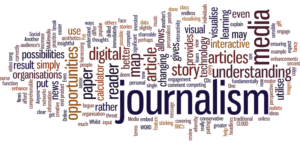Written and compiled by Adekanbi Odunayo S.
The Polytechnic Ile-Ife, Osun State
In an era where information is abundant yet trust in news is waning, precision journalism has emerged as a critical tool for truth-telling. Unlike traditional reporting that often relies on anecdotes or personal observations, precision journalism uses data, statistical analysis, and scientific methods to uncover patterns, validate facts, and reveal hidden stories. This shift toward data-driven reporting is not only changing how news is gathered and presented but also reshaping the role of journalists in the digital age. As newsrooms increasingly adopt precision reporting techniques, the power of numbers is offering a clearer, more accurate view of the world—helping to cut through noise, misinformation, and biases.
What is Precision Journalism?
Precision journalism, first introduced by Philip Meyer in the 1960s, brings together the rigor of social science research with the storytelling craft of journalism. By incorporating data analysis, surveys, and statistical tools, journalists can move beyond surface-level reporting to provide deeper insights. As the digital landscape floods the public with information from a range of sources, precision journalism helps separate facts from assumptions by using verifiable data to tell compelling, credible stories.
Data as the New Source
The digital age has transformed how journalists source their information. While traditional journalism often relied on eyewitnesses and expert opinions, precision journalism treats data itself as a source. From government datasets and health records to social media trends and satellite imagery, raw data is increasingly at the center of impactful stories. The ability to harness this data enables journalists to uncover trends, predict future developments, and analyze events with a level of depth that would be impossible through human observation alone.
For example, investigative journalism is taking new forms thanks to precision reporting. Complex issues like climate change, political corruption, and health crises can now be analyzed through data sets that reveal patterns of behavior or anomalies that traditional methods might miss. In doing so, precision journalism shifts the focus from just reporting what happened to explaining why and how it happened.
Empowering Audiences with Facts, Not Opinions
In a time when audiences are bombarded with biased and opinion-based content, precision journalism stands out by prioritizing facts and evidence. Numbers don’t lie, and when used properly, they empower both journalists and readers to see beyond sensational headlines and emotional rhetoric. Through clear data visualization—such as infographics, graphs, and interactive tools—news consumers are given the tools to understand complex issues for themselves.
This approach helps combat misinformation by providing evidence-backed reporting. In a post-truth era, precision journalism serves as a necessary antidote to speculation, propaganda, and fake news.
The Role of Technology in Precision Reporting
The explosion of big data and advances in technology have given precision journalism new momentum. With tools like artificial intelligence (AI), machine learning, and data-mining software, journalists are equipped with advanced capabilities to analyze massive amounts of information. For instance, AI can be used to detect trends in social media conversations, or data-mining algorithms can reveal hidden connections in vast financial records.
Beyond data collection and analysis, digital tools also allow for more engaging storytelling formats. Journalists are able to turn complex datasets into interactive visual stories, offering readers the chance to explore the data for themselves. The combination of powerful storytelling with robust data analysis is redefining how news is delivered, making it more accessible and interactive.
Challenges in Precision Journalism
While precision journalism offers immense potential for improving the accuracy and depth of reporting, it also presents several challenges that both journalists and newsrooms must navigate carefully. These challenges arise from issues related to data availability, journalist training, the risk of misinterpretation, ethical considerations, and the potential for over-reliance on data-driven narratives.
Data Misinterpretation and Manipulation
One of the core challenges of precision journalism is the risk of misinterpreting or manipulating data. Data, while objective in nature, can be easily misused when presented without the proper context or understanding. Journalists who lack training in data analysis might draw incorrect conclusions or present misleading statistics, unintentionally fueling misinformation.
For example, correlation does not always imply causation, but without careful statistical analysis, journalists may incorrectly link two unrelated trends. A minor statistical anomaly could also be presented as a major trend, leading to sensationalism. Misinterpretations like these can undermine the credibility of both the publication and the profession as a whole.
Furthermore, the intentional manipulation of data to fit a preconceived narrative poses a significant ethical challenge. Journalists must ensure that the data they present is accurate, unbiased, and contextualized to avoid misguiding their audience.
Limited Access to Quality Data
Another significant challenge is access to high-quality, reliable data. While we live in a world flooded with information, not all of it is accurate, complete, or easily accessible. In some cases, journalists may struggle to obtain datasets from governments, corporations, or institutions that withhold information due to political, financial, or legal reasons.
This issue is particularly pronounced in countries with poor transparency or repressive regimes, where journalists face significant barriers to accessing public records or conducting surveys. Even in more transparent societies, journalists may encounter bureaucratic hurdles when attempting to access crucial data through freedom of information laws. As a result, a lack of data can lead to incomplete stories or force journalists to rely on less credible sources.
Moreover, journalists often encounter challenges with the accuracy or consistency of data. For instance, discrepancies in how data is collected, stored, or reported can make it difficult to draw reliable conclusions. Data cleaning and verification processes can be time-consuming and resource-intensive, posing additional obstacles for newsrooms with tight deadlines.
Training and Skills Gap
Precision journalism requires a blend of traditional journalistic skills and more technical abilities, such as data analysis, coding, and statistical literacy. Unfortunately, many journalists today lack the training necessary to navigate these technical aspects effectively. Data analysis requires a strong grasp of mathematical concepts, knowledge of software tools, and the ability to discern meaningful patterns within complex datasets.
Newsrooms may face a steep learning curve as they attempt to train journalists in data science skills or hire new specialists to fill the gap. Smaller, resource-constrained news organizations, in particular, may struggle to invest in the necessary training or hire skilled data analysts.
Furthermore, even with adequate training, journalists must maintain a delicate balance between data interpretation and storytelling. The challenge lies in communicating complex data in a way that’s both accurate and accessible to the general public. This requires journalists to master the art of data visualization and storytelling without oversimplifying or distorting the underlying information.
Over-Reliance on Data-Driven Narratives
While data can provide powerful insights, there’s a danger in over-relying on it as the sole basis for reporting. Precision journalism, by its nature, emphasizes quantifiable evidence, but not all stories can be fully captured in numbers. Human experiences, emotions, and narratives are often difficult to quantify, and stories that rely exclusively on data can risk losing the human element.
For example, reporting on poverty or inequality might benefit from hard data on income distribution or employment rates, but it also requires the personal stories of those impacted to convey the emotional depth of the issue. Over-reliance on data-driven narratives can result in sterile reporting that lacks empathy or fails to address the broader social and emotional dimensions of a story.
Journalists must be cautious not to reduce complex social phenomena to just numbers and graphs. Balancing quantitative data with qualitative insights, such as interviews or personal testimonies, is essential to ensure comprehensive and compelling reporting.
Ethical Considerations and Data Privacy
As journalists increasingly rely on data, ethical considerations surrounding data privacy and security become more pressing. Data, especially when it involves sensitive personal information, must be handled responsibly to avoid breaches of privacy or ethical violations. This is particularly critical when dealing with datasets that contain personally identifiable information (PII), health records, or other confidential data.
Journalists must navigate legal frameworks such as the General Data Protection Regulation (GDPR) in Europe or other privacy laws that govern how personal data is collected, stored, and shared. Misuse or mishandling of sensitive data can not only lead to legal consequences but also harm individuals and erode public trust in journalism.
In addition, ethical questions arise around the use of data gathered without consent, such as information scraped from social media platforms. Journalists need to establish clear guidelines on how they obtain, analyze, and present data while respecting the privacy rights of individuals involved.
These challenges highlight the complex landscape of precision journalism. While the potential benefits are substantial, journalists must approach data with care, ensuring that their reporting is accurate, ethical, and balanced with human insight. Balancing technological advances with journalistic principles is key to the successful integration of precision journalism into the future of news.
A New Era of Accountability
As precision journalism grows, so does the responsibility of the press to provide fact-based, data-driven reporting. With misinformation spreading rapidly across digital platforms, journalism that relies on objective data is essential to maintaining public trust. By leveraging the power of numbers, journalists are not just reporting on the world—they are actively helping to shape a more informed, engaged, and accountable society.
This new era of journalism, built on the foundation of accuracy, transparency, and evidence, is crucial for the future of democracy. In an age of endless information, precision journalism offers a way to cut through the noise and bring meaningful stories to light.

Ibraheem GBADEGESIN is a versatile content writer and web designer with over five years of experience. Specializing in WordPress, SEO, and website monetization, he has helped businesses like InfoGiant FM and DNewsInfo grow their online presence. Known for his creative solutions and technical expertise, Ibraheem is committed to delivering engaging web projects that drive results and help clients succeed.









